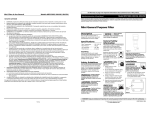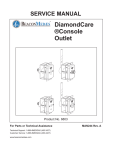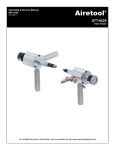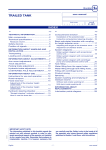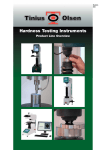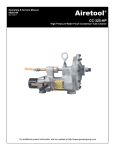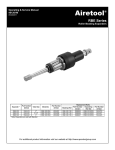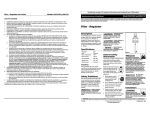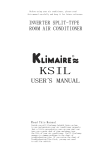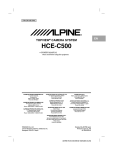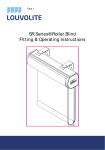Download OPERATING/SERVICE INSTRUCTIONS
Transcript
OPERATING & SERVICE MANUAL # 90113-IM REV 11/29/00 Airetool ® Model PATP 9000 Ram (5524902) Model PATP 9400 P Hydraulic Pump (2999307) Model PATP HT Hose Tube Assembly (5524903) READ SAFETY RECOMMENDATIONS BEFORE OPERATING THIS TOOL AIRETOOL OPERATION 302 South Center Street Springfield, Ohio 45506 Page - 1 Safety Recommendations WARNING: FOR YOUR SAFETY AND THE SAFETY OF OTHERS, READ AND UNDERSTAND THE SAFETY RECOMMENDATIONS AND OPERATING INSTRUCTIONS BEFORE USING THIS TOOL. 1. KNOW YOUR POWER TOOL – Read your operating and service manual carefully. Learn its applications and limitations as well as the specific potential hazards particular to this tool. 2. DISCONNECT TOOLS – when not in use, before servicing, when changing accessories such as grippers and draw rods, etc. 3. AVOID AGAINST ACCIDENTAL STARTING – Do not carry the tool with your finger on the switch. Be sure the shut off valve is in the off position before connecting the air supply to this tool. 4. KEEP HANDS AWAY FROM ALL MOVING PARTS. 5. STAY ALERT – Watch what you are doing and use common sense. 6. ALWAYS WEAR PROTECTIVE EQUIPMENT: For additional information on eye and face protection, refer to Federal OSHA Regulations, 29 Code of federal regulations, Section 1910.133 eye and Face Protection, and American National Standards Institute, ANSI A87.1, Occupational and Educational Eye and Face Protection Z87.1 is available from the American National Standards Institute, 1430 Broadway Avenue, New York, NY 10018. Page - 2 Hearing protectors are required in high noise areas, 85dBA or greater. The operation of tools and equipment in the area, reflective surfaces, process noises and non-resonant structures can substantially contribute to and increase the noise level in the area. For additional information on hearing protection, refer to Federal OSHA Regulations section 1910.95 Occupational Noise Exposure, and the American National Standards Institute, ANSI S12.6 Hearing Protectors. Some individuals are susceptible to disorders of the hands and arms when exposed to task which involve highly repetitive motions or vibration. Those individuals predisposed to vasculatory or circulation problems may be particularly susceptible. Cumulative trauma disorders such as carpal tunnel syndrome and tendonitis can be caused by repetitions, forceful exertions of the hands and arms. These disorders develop gradually over periods of weeks, months, and years. • Tasks should be performed in such a manner that the wrists are maintained in a neutral position which is not flexed, hyperextended, or turned side to side. • Stressful postures should be avoided and can be controlled through tool selection and work location. Any user suffering from prolonged symptoms of tingling, numbness, clumsiness or weakened grip, nocturnal pain in the hand or any other disorder of the shoulders, arms, wrists, or fingers is advised to consult with a physician. If it is determined that the symptoms are job related or aggravated by movements and postures dictated by the job design it may be necessary for the employer to take steps to prevent further occurrences. These steps might include, but are not limited to repositioning the workpiece or redesigning the work station, reassigning workers to other jobs, rotating jobs, altering work pace, and / or changing the type of tool used so as to minimize stress on the operator. Some task may require more than one type of tool to obtain the optimum operator/tool/task relationship. The following recommendations will help reduce or moderate the effects of repetitive work motions and/or extended vibration exposure. · Use a minimum hand grip force consistent with proper control and safe operation. · Keep wrist as straight as possible. · Keep body and hands warm and dry. · Avoid anything that inhibits blood circulation - Smoking tobacco - Cold temperatures - Certain drugs · Avoid highly repetitive movements of hands and wrist, and continuous vibration exposure. Follow good machine shop practices. Rotating shafts and moving components can entangle and entrap, and can result in serious injuries. Never wear long hair, loose fitting clothes, gloves, ties, or jewelry when working with or near the equipment. Use of this tool may produce hazardous fumes, particles and/or dust form the tube or vessel they are being extracted from. To avoid adverse health effects utilize adequate ventilation and/or a respirator. Read the material safety data sheet of any fluids or other materials involved in the tube removal process. Page - 3 Model PATP 9400 Ram (5524902) T O O L S P E C I F I C A T I O N S: Maximum Operating Pressure - 10,000 PSI (650 Bar) Pulling Capacity @ 10,000 PSI (690 Bar) - 13 3/4 Tons (12.5 Metric Tons) Pulling Stroke - 2-3/8” (60 mm) Length - 23 3/8” (594 mm) Side to Center Distance - 3 5/8” (92.1 mm)Approx Tube Pulling Capacity - 5/8” thru 1” OD (16 thru 25 mm) United States European Office Cooper Power Tools Airetool Operation 302 South Center Street Springfield, Ohio 45506 Phone: 937/323-4981 – Fax: 937/323-6524 Intercontinental U.S. Fax: 1-800/375-8906 Cooper Power Tools B.V. P O BOX 522 2900 AM Capelle –A/D Ijssel The Netherlands Phone: 31-10-4588722 – Fax 31-10-4587173 Telex: INBV NL Page - 4 Model PATP-9000 Hydraulic Tube Puller 1. 4. 2. 3. Tube Pulling System Complete Consists Of : 1. 2. 3. 4. PATP 9000 PATP 9400 P PATP HT ATP 9022 XXX Ram Assembly Hydraulic Pump Unit Hose-Tube Assembly Gripper Kit ( XXX See Chart On 5524902 2999307 5524903 Page 14 ) Page - 5 OPERATING & SERVICE INSTRUCTIONS FOR Model PATP-9000 TUBE PULLER THIS SYSTEM IS CAPABLE OF GENERATING 13 3/4 TONS OF FORCE AT 10,000 PSI, THEREFORE, DO NOT OPERATE THIS SYSTEM BEFORE FULLY READING AND UNDERSTANDING THE SET-UP AND OPERATING INSTRUCTIONS. ALWAYS WEAR EYE PROTECTION WHEN USING THIS EQUIPMENT. BEFORE STARTING THE PUMP UNIT 1) To avoid possible serious injury to personnel or equipment, always post DANGER SIGNS (Part. No. 2987064) and insure that the area directly behind the tube sheet/ bundle is kept clear and that a suitable barrier is in use while using the puller. If a draw rod should break while pulling tube stubs or tubes, the draw rod tip, cam and expansion nut can be propelled out into this area with considerable force. 2) Make sure the vented filler cap/fill gauge is installed. rolled section be measured with an AIRETOOL Tube Gage. See Gripper Selection chart on Page 14. DRAW ROD-EXPANSION NUT- LOCK NUT SELECTION: These three components must match the gripper chosen (if necessary a second expansion nut may be used instead of a lock nut). See Gripper Selection chart on Page 14. NOSE BUSHING SELECTION: The bushing ID must be large enough to clear the tube OD (including flared or belled ends), and the bushing OD must be small enough so that it does not interfere with adjacent tubes protruding from the tube sheet. Standard nose bushings accommodate tubes that have not been flared or belled. NOTE: It may be necessary in some applications where the tubes are brittle and/or if the grippers are positioned over tube sheet serrations (grooves), to shorten the nose bushing to allow the grippers to seat further into the tube sheet. Care must be taken that the cut be smooth and square to avoid gripper breakage. Since the bushing is casehardened, a lathe with carbide tooling is recommended. 3) Check oil level (see pump manual # 90120-IM). Standard Nose Bushing sizes: 4) Check hose for leaks, cuts, abrasions or bulges—read and fully understand the warning tags attached to the hose assemblies. Check hose’s label and fittings for underrated replacement parts. NEVER operate with damaged hoses and/or cords. NEVER allow hoses and/or cords to kink or knot. NEVER place hoses in an area where they may be stepped on or run over by any type of vehicle, cart, hand truck, etc. NEVER connect any hydraulic fitting, hose or device to the hydraulic portion of the pump that does not carry a 10,000 psi rating. 5) Make sure all hose and control tube connections are fully coupled. 6) Check air supply for sufficient capacity (see pump unit nameplate). Note: A ½” ID x 10’ long supply hose is recommended. If a longer hose is required, ¾” ID or larger will provide best performance. The use of quick disconnects will decrease performance unless they are sufficiently oversized or of an unrestricted flow type. GRIPPER SELECTION: Grippers are sized for nominal ID/OD brass tubes rolled with normal wall reduction in tube sheet holes with normal clearance. Tubes with smaller than normal rolled ID’s may require the use of a smaller gripper for smooth release of the tube after pulling. Tubes with larger ID’s may require the use of a larger gripper to avoid the excessive bending of the gripper and prolong gripper life. For determining the most suitable gripper, it is recommended that the tube’s Page - 6 SIZE I.D. 5/8 “ 3/4“ 7/8 “ 1“ 11/16 “ 7/8“ 31/32 “ 1 3/16 “ O. D. 29/64 “ 1 1/8 “ 1 11/64 “ 1 5/16 “ GRIPPER KIT INSTALLATION Lubricate the threads of the draw rod with an anti-galling compound, thread the draw rod into the piston rod and snug with a wrench. Thread proper size gripper adapter (2) into the outside piston. With the two O-rings in place, slide the gripper complete (3 segments) over the draw rod such that the segments are aligned and spaced by the adapter lugs and retained with the proper sized gripper retainer (1) tightened securely. Lubricate the cam and thread the cam and lock nut onto the end of the draw rod until the cam contacts but does not expand the gripper—see Gripper Adjustment below. SETTING UP THE EQUIPMENT Connect the pump to an adequate air supply with appropriate hoses. Inadequate air supply can cause poor pump performance and prevent the pulling of some tubes. Make sure that the work area is arranged to provide adequate room for movement and protection of the supply and operation hoses. Make sure that the vented filler cap/level indicator is installed on the pump (see pump manual #90120- OPERATING/SERVICE INSTRUCTIONS IM). Connect the hose /tube assembly to the pump and tube puller assembly. Hydraulic connections push together until they snap. Control tube connections should be properly keyed and threaded securely. When the pump motor is started, the ram will (if not fully forward) move to the full reset position, build enough pressure to trip an internal unloader, and then idle. FULL SYSTEM PRESSURIZING OF THE RETURN HOSE AT THE RESET POSITION INDICATES A MALFUNCTION OF THE PUMP - immediately stop the motor by pushing the red button on the pump and/turning of the air shut-off valve and clear the malfunction before proceeding. Cycle the puller assembly several times to warm the system before setting the gripper. GRIPPER ADJUSTMENT Pull the trigger until the gripper starts to move (the draw rod moves about 3/8" first) to put the puller in the grippersetting position. Turn the motor off (by pushing the red MOTOR STOP button on the pump) and measure the diameter of the back tooth. If it is not at least .020" larger than the ID of the tube to be pulled, adjust the expansion nut in until it is. Make sure that the correct gripper size is being used since over-expansion of an undersized gripper will decrease gripper life. NOTE: Very hard tubes cannot be pulled in a conventional manner with this tool since the gripper teeth will slide instead of gripping into the surface of the tube. Tighten the lock nut against the expansion nut and confirm that the draw rod is tight. Install the nose bushing and lock it in place with one of the set screws. SERVICE INSTRUCTIONS Most hydraulic cylinders give relatively long life and good dependability when they are used within their design parameters. The use of approved clean hydraulic fluid is essential if good seal life is to be expected (see pump manual #90120-IM). It is also essential that care be taken when coupling the hoses to the cylinder and pump to avoid getting dirt or other contamination into the system where it could abrade the seals and cause them to leak. DISASSEMBLY (Refer to the exploded view drawing on the following page for the item numbers referenced.) Note: All threaded components have right-hand threads. HANDLE/ LIMIT SWITCH REMOVAL 1. Clamp the puller upside down in a soft jaw vise so that the puller is securely held with the hydraulic connections pointed up. 2. Remove switch cover screws (6) and cover (8). 3. Remove the limit valve mounting screws (10 ). -continued- 4. Remove the handle mounting screw (41). Loosen the handle mounting set screws (38), and remove the handle assembly, tubing conduit (14) and limit valve (11) assembly, taking care not to damage the tubes when pulling them through the slot in the switch box. 5. Inspect the valve roller and arm for free operation and clean if necessary, or replace if damaged. 6. Carefully inspect the handle tubing for deterioration, damage or loose connections and replace if required. CYLINDER DISASSEMBLY It is strongly recommended that PATP cylinders be returned to Airetool for repairs involving removal of the cylinder plug. The following instructions are provided for use only by knowledgeable service personnel using appropriate facilities and equipment. 1. Remove the gripper retainer (1), gripper, draw rod, nose bushing, and gripper adapter (2). 2. Unscrew the nose bushing adapter (3). 3. Thoroughly clean all exposed surfaces of the puller with a suitable solvent and blow dry. NOTE: All further operations must be performed in a thoroughly clean environment to avoid premature failure of the puller or pumping unit due to contamination. 4. Remove the hydraulic couplings (12 and 13) and drain out as much of the hydraulic fluid as possible. 5. Securely attach a heavy steel bar to the ¼-20 threaded holes in the cylinder plug with three grade 8 cap screws and loosen the plug. The cylinder must be held securely toward the nose end of the cylinder and with the torque reacted against the suspension eye boss and not the hose connections. 6. Remove the cylinder plug and any hydraulic fluid remaining in the cylinder. Inspect the O-ring (33) and replace if cut or worn. 7. Using a suitable drift to avoid damaging the rod threads, carefully press the piston assembly out of the case. Take care to catch the oil remaining below the piston assembly. 8. Pull the piston (29) assembly out of the outside piston (20) assembly. 9. Inspect the rod seal (25) and piston seals (24) for cuts or wear, but do not attempt to remove them unless replacement is intended. To remove a rod or piston seal, pull the seal away from the piston (or rod) and very carefully cut through the seal with a very sharp, thin blade, taking care to avoid scratching the piston or rod. 10. The valve plunger (30) and spring (31) can be removed from the piston (29) after unscrewing the set screw (32). 11. The valve seat (23) can be unscrewed from the outside piston (20) to remove the ball (22) and spring (21). The spring should be approximately 1 1/8” long. If it has Page - 7 OPERATING/SERVICE INSTRUCTIONS deformed, replace it. Carefully inspect the ball and valve seat and replace if damaged. 12. The cylinder seal (15) can be removed from the cylinder case after removing the snap ring (16) (with long snap ring pliers). RE-ASSEMBLY NOTE: When assembling seals into parts or parts into seals, always lubricate with clean hydraulic fluid, O-Lube or petroleum jelly. Everything that comes in contact with the hydraulic fluid must be kept clean. 1. Install the cylinder seal (15) into the case (4) oriented as shown and retain with the snap ring (16). 2. The pin (28) is pressed into the piston (29). 3. Install rod and piston seals oriented as shown. 4. Install spring (21) ball (22) and valve seat (23) in outer piston (20) and tighten securely. 5. The piston rod (26) is screwed into piston (29) and secured with Loctite® 242. 6. Install valve plunger (30), spring (31) and set screw (32) in the piston (29) with the screw flush with the piston face and secured with 242 Loctite® or equal. Allow Loctite® to set and clean thoroughly. 7. With the spacer (27) over the pin (28), slide the piston assembly into the outside piston assembly with the pin going into the hole in the outside piston. 8. Install o-ring (33) in groove in the cylinder plug (34) and screw cylinder plug into case (4). Start the O-ring into the case with a blunt instrument to avoid pinching it. Securely tighten cylinder plug. 9. Loctite® (pipe sealant) couplings (12 &13) to case (4). Note that the male coupler goes on the gripper end. 10. If the wiring harness has been removed, feed the trigger switch and wiring up through the receptacle hole and install receptacle (36) with screws (37). Feed the cord out through the wire conduit hole. 11. If the plunger replacement is required, screw the spring plunger (32) into the handle (40) from the front (using an installation tool engaged in the slots in the plunger end) so that the trigger bottoms out against the plunger body before it hits the bottom of its cavity in the handle and properly trips the switch when pulled fully. 12. Arrange the control tubing in the handle so that it will stay in the cavity (under the retaining pin) and insert gasket (49) into handle (40). 13. Feed tubing and conduit into limit valve box on case (4) and attach handle (40) to case with screw (41) making sure that no tubes get pinched and that the handle is aligned properly. 14. Tighten set screws (38). 15. Connect tubing to limit valve (11) as shown in connection diagram. 16. Install limit valve (11) assembly into case (4) with screws (10) as shown – leave screws loose enough to adjust Page - 8 -continued- limit valve plate. 17. Connect the cylinder to a properly functioning ATP pump and hose/tube assembly. 18. With all personnel clear of the unit, connect the air supply and turn on the main air shut-off valve. 19. Adjust the limit valve so that it does not hiss, but any further actuation of the arm will start the hiss. Tighten the screws and test for proper sequencing of the unit with the trigger and proper adjustment of the limit valve. 20. Install limit switch cover (8) with screws (6). 21. Install a draw rod and check for proper cycling and check all connections for leaks before returning unit to service. PULLING TUBES 1. Inspect the face of the tube sheet and tube ID’s. Any chips, dirt or scale which would prevent the nose bushing from bearing squarely on the tube sheet or debris inside the tube that will prevent the grippers from biting into the tube material must be removed or the effectiveness and life of the grippers will be greatly reduced. 2. The puller assembly will pull itself square to the tube sheet as it starts its cycle; however holding the assembly reasonably square first will prolong gripper and draw rod life. Use of a suitable tool balancer or Model DAS tool positioner is recommended for reducing operator fatigue. 3. Never attempt to pull tubes at an angle to the tube sheet or serious injury to the operator and/or the equipment may result. If obstructions prevent proper in-line access to the tubes, extension assemblies are available to assist in pulling these tubes. 4. With the gripper kit installed and set, with hose/tube assembly properly connected, pump connected to an adequate air supply and the area behind the tube sheet and/or bundle cordoned off with warning signs displayed, turn on the air shut-off valve. With everything clear of the grippers, pull and hold the trigger.The ram will continue back until the trigger is released or the limit valve is tripped at the end of the stroke. The motor will continue to run until the red MOTOR STOP button on the pump is pushed (or the air is turned off). 5. Cycle the puller assembly several times to warm it up. 6. Insert the gripper into the tube to be pulled with the puller nose bushing pushed squarely against the tube sheet. Pull and hold the trigger. 7. After the tube pulls tight against the tube sheet, pull back lightly on the puller. When the tube pulls free, release the trigger and pull the stub/tube from the tube sheet as the puller assembly is retracting. The gripper will release the tube just before the puller resets fully. In some extreme OPERATING/SERVICE INSTRUCTIONS cases, the gripper teeth may stick in the tube, but can usually be released by momentarily pulling the trigger for a short cycle outside the tube sheet. 8. If the puller assembly reaches the end of its useable stoke, it will automatically reverse, reset and stop. The trigger can be released at any time during the pulling portion of the cycle to immediately reverse the ram or it can be released without effect at any time after the puller has been reversed by the end-of-stroke switch but it must be released at the reset position before another cycle can be started. The pump motor starts when the trigger is pulled the first time, and remains running until the red MOTOR STOP pushbutton valve on the pump is pushed. 9. If the tube does not pull free with a single pull attempt (approx. 2-3/8" stroke), the gripper can be pushed forward into the tube for a second pull (this may become necessary in tube sheets thicker than the 2-3/8"). If additional pulls are required to break the tube free, tubular spacers may be used equal to the length of the tube protruding from the tube sheet. 10. When using spacers to make multiple pulls, care should be taken to avoid interference with adjacent tubes. 11. If the tubes break off in short sections (rings) instead of pulling free, the gripper teeth may need to be positioned further into the tube sheet. This can be accomplished by shortening the nose bushing on a lathe (Must be machined square. Carbide tooling recommended). DO NOT ALLOW THE GRIPPERS TO BE POSITIONED BEHIND THE TUBE SHEET.This can result in equipment breakage and/or injury to personnel. NOTE: 1. The puller will pull only as long as the trigger is held. Releasing the trigger will cause the puller to immediately retract fully and stop. 2. The trigger must be released with the puller fully reset before a new cycle can be started. 3. The cycle can be stopped at any point by turning the pump off. 4. Once a cycle has been started, the motor will run until it is turned off (red MOTOR STOP pushbutton valve on the pump unit). 5. The draw rod should always move (about 3/8") before the gripper moves at the beginning of a cycle and should always move (about 3/8") after the gripper stops at the end of its cycle (or less if self adjusting has occurred). 6. The weight of the puller assembly should always be supported by the operator, a balancer or a DAS unit and not by the gripper. Resting the puller on the grippers can cause the grippers and draw rod to bend and cause premature failure. -continued- 7. Allowing the unit to dwell at full pressure serves no purpose and can damage the equipment. Should overheating occur, turn the motor off and let the unit cool before attempting to pull more tubes. IMPORTANT: If the unit is not operating properly, DO NOT USE IT - see Trouble Shooting section or contact authorized AIRETOOL representative to correct the problem before using the equipment. SHUTDOWN After using the puller in a wet, dirty or corrosive area, always clean and oil the tube puller assembly and the gripper kit before putting the tool away or severe corrosion can occur. Removal of the gripper kit for prolonged storage is recommended. To further protect the working end of the piston, you can retract it fully and turn the motor off before storage. Note that you must release the trigger before releasing the red pushbutton on the pump, or the pump motor will restart. PRINCIPLE OF OPERATION Oil directed to the rod end of the cylinder assembly flows through the check valve in the outside piston (20) as long as the ball (22) is held off its seat (23) by the valve plunger (30). This causes the piston to retract, pulling the draw rod back and expanding the gripper. When the piston has moved about 3/8" away from the outside piston, the ball seats, trapping oil between the pistons and the two pistons move back as a unit, pulling both the gripper and the draw rod with no further expansion of gripper. When a tube is being pulled, the pressure between the pistons starts to rise as soon as the gripper starts to grip the tube, pushing the valve plunger (30) back against its spring (32). When enough pressure has built up to fully grip the tube, the valve plunger has been pushed back far enough to allow the check valve in the outside piston to seal off so that expansion stops and the tube is pulled by the gripper and not the draw rod. On the reset stroke, the outside piston stops when it bottoms out on the case. The oil between the pistons escapes past the ball in the outside piston. When the piston (29) bottoms out, the system pressure rises enough to trip the internal pump unloader and the pump shifts back to its idle position. Page - 9 TROUBLE SHOOTING S E E S E R V IC E M A N U A L N U M B E R 90 1 20 -IM FO R H Y D R A U LIC P U M P M O D E L P A TP -9 40 0-P G rip per slips ou t o f tub e w ith out gripping Exce ssive d ra w ro d breaka ge Pum p w ill not bu ild e noug h pressu re to pull (u nder 10,000 psi) 1 ) G ripp ers w orn out (teeth d ull) - repla ce grippers. 2 ) T urn adjusting n ut in for m o re gripper expa nsion 3 ) C h eck tu be hard ness p uller w ill n ot pull excessively w o rk- or ag e- harden ed tub es 4 ) C h eck valve spring (3 1) a nd scre w (32) - re place if d am age d or out of po sition . Puller bottom s out and press urize s on pu ll strok e but reve rs es w he n trig ger is releas ed. 1 ) C heck lim it valve - adjust th e va lve plate so that valve shifts only w he n on the cam . 2 ) C heck fo r p inched tub es. Puller w ill not m ove from the idle po sitio n. 1 ) M ake su re both e nds of the tu bing conn ectors a nd pu lle r h oses are prop erly conn ected 2 ) M ake su re trig ger valve is fu nctio ning pro perly. 1 ) C h eck o perator techn ique 2 ) If brea ka ge continu es w ith p ro per techniq ue, check th at valve ba ll (22 ) sea ts a nd that valve plu nger (30) m o ve s p ro perly. W hen first started a fte r servic e, th e puller retracts fully and s to ps w ith the press ure sw itch trippe d instea d of going into res et (or staying in id le .). C heck hose, pum p and p uller cou plings. 1 ) M a ke su re ve nted filler cap level g age is installed on p um p. 2 ) C h eck o il le ve l (w ithin g re en zone -se e pum p m a nual). 3 ) C h eck a ir p re ssure w ith p um p un der load . Air supp ly a nd supp ly ho se m ust h ave e noug h capacity to ru n pum p w ith out excessive pre ssure d ro p. 4 ) If pum p requires servicin g see E N ER PA C lite rature for locatio n of neare st EN ER PAC service center . P U M P - left is fem a le, rig ht is m ale. H O SES – o ne m ale and on e fe m ale on e ach hose. P U LLE R – m ale in front an d fe m ale in ba ck. - C A U T IO N D O N O T A T T E M P T T O D IS C O N N E C T O R D IS A S S E M B L E H O S E S , P U LLE R O R V A LV E W H ILE T H E Y A R E P R E S S U R IZE D O R S E R IO U S IN JU R Y C O U LD R E S U LT. T H E U N IT C A N N O R M A LLY B E D E P R E S S U R IZE D B Y T U R N IN G O FF O R D IS C O N N E C TIN G T H E A IR S U P P L Y . IF T H IS IS N O T E F F E C T IV E , D E P R E S S U R IZ E B Y LE T TIN G T H E A S S E M B L E D U N IT S IT (W ITH T H E A IR D IS C O N N E C TE D ) U N T IL T H E P R E S S U R E B L E E D S O F F . T O D E P R E S S U R IZE A D IS C O N N E C T E D C O M P O N E N T , S H R O U D T H E JO IN T A N D S L O W L Y U N S C R E W A F IT T IN G U N T IL P R E S S U R E IS R E L IE V E D . A LW A Y S K E E P T H E F IT T IN G W E L L A W A Y F R O M A N Y B O D Y C O N TA C T A N D W E A R E Y E P R O TE C T IO N . Page - 10 NOTES: Page - 11 Model PATP-9000 ( 5524902 ) Hydraulic Ram ( See Parts List Page 13 ) Page - 12 PARTS LISTING FOR PATP-9000 RAM (See Drawing Page 12) ITEM PART # 1 1 2 2 3 4 5 6 8 10 11 12 13 14 15 16 17 19 20 21 22 23 24 25 26 27 28 29 30 31 2991214 2991236 2991213 2991235 2991231 2991190 8010204 8010210 2999063 8010912 2999066 2995267 2995268 2991234 2991229 8010497 8564870 8010029 2991195 2991208 3227500 2991207 2991228 2991230 2991193 2991210 2991209 2991194 2991211 2991212 DESCRIPTION ATP 9012 5/8 3/4 GRIPPER RETAINER ATP 9033 7/8 1 GRIPPER RETAINER ATP 9011 5/8 3/4 ADAPTER ATP 9032 7/8 1 ADAPTER 7/8 1 ATP 9026 7/8 1 ADAPTER 7/8 1 ATP 9001 CYL CASE ASSEM 1/4 20 X 1/4 NYLOK SET SCREW 4 40 X 1/4 BUTTON HD SCREW ATP 9029 B SWITCH COVER 8 32 X 5/16 FHCS 18 8 PATP 3 LIMIT VALVE HDP 30 13A NIPPLE SFWY HDP 30 14A COUPLER SFWY ATP 9031 WIRE CONDUIT ATP 9020 CYLINDER SEAL 5008 150 SNAP RING 1700 32 SUPPORT EYELET 5/16 18 HEX NUT ATP 9002 OUTSIDE PISTON ATP 9006 CHECK VALVE SPRING 1/4 STEEL BALL ATP 9005 VALVE SEAT ATP 9019 PISTON SEAL ATP 9021 ROD SEAL ATP 9004 PISTON ROD ATP 9008 SPACER ATP 9007 PIN ATP 9003 PISTON ATP 9009 VALVE PLUNGER ATP 9010 REG VALVE SPR REQ'D ITEM PART # 1 1 1 1 1 1 2 4 1 2 1 1 1 1 1 1 1 1 1 1 1 1 3 1 1 1 1 1 1 1 32 33 34 35 36 37 38 39 40 41 42 43 44 45 46 47 48 49 50 51 52 53 54 55 56 57 58 59 60 61 8010496 2983298 2983310 8010914 2999068 8010915 8010204 2983330 2991253 8010209 8010222 2983286 2983283 8010206 8010084 2999067 8010357 2983300 2999069 2999070 8010913 8010500 2999065 8009100 2999064 8010083 2999244 2999245 2999246 8007100 DESCRIPTION 5/16 24 HOLO LO HOLO LOK SET SCREW ATS 8825 O RING ATS 8814 CYLINDER PLUG 4 40 X 1/2 SHCS PATP 5 ADAPTER M4 X 10 PHMS DIN 85A 1/4 20 X 1/4 NYLOK SET SCREW 1/4 20X3/16 STROKE SPRING PLUNGER ATP 9044 HANDLE 1/4 20 X 1 BUTTON HD SCREW 4 40 X 1/4 FLAT HD CAP SCREW ATS 8818 TRIGGER COVER ATS 8817 TRIGGER 1/8 X 1 DOWEL PIN #6 LOCK WASHER PATP 4 HANDLE VALVE 6 32 X 1/2 SOC HD CAP SCREW ATS 8815 GASKET PATP 6 BOX CONNECTOR PATP 6 I CON INSERT 6 32 X 1/4 HHMS 18 8 6-32 X 1/4 HEX NUT PATP 2 VALVE CAM 10 32 X 1/8 SOC SET SCREW PATP 1 VALVE PLATE 8 32 HEX NUT PATP 10 3/32 TUBE BARB PATP 11 3/32 TUBE TEE PATP 12 3/32 ID TUBING 6-32 X 3/16 SOC SET SCREW REQ'D 1 1 1 4 1 4 4 1 1 1 2 1 1 2 4 1 4 1 1 3 1 1 1 1 1 1 4 1 3.5 1 Page - 13 GRIPPER KITS & COMPONENTS FOR Airetool Models ATP & PATP Semi-Automatic Tube Pullers GRIPPER KITS AND COMPONENTS For Models ATP and PATP Tube Pullers TUBE SIZE * GRIPPER ** GRIPPER O. D. GAGE SEGMENT COMLETE 5/8 " 3/4 " 7/8 " 1" 16-18 20-22 14-15 16-18 20-22 12-14 16-18 20-22 12-14 16-18 20-22 2991196 2991197 2991198 2991199 2991200 2991201 2991202 2991203 2991204 2991205 2991206 5520793 5520794 5520795 5520796 5520797 5520798 5520799 5520800 5520801 5520802 5520803 *** GRIPPER NOSE KIT BUSHING 5520782 5520783 5520784 5520785 5520786 5520787 5520788 5520789 5520790 5520791 5520792 DRAW ROD 2991245 2991237 " " 2991218 2991244 " " " " 2991232 2991240 " 2991244 " " " " " " EXPANSION NUT LOCK NUT FRONT REAR "O" RING "O" RING 2991238 " 2991226 " " 2991241 2991239 " 2991227 " " 2991242 3105400 " " " " 3010453 3094500 " " " " 3220900 " " " " " " " " " " " " " " " " * Gripper segment only - 3 required for set. ** Gripper complete - Consists of 3 segments, 1 front "O" Ring and 1 back "O" Ring. *** Gripper Kit - Consists of 3 segments item # 1, and one each of items 2, 3, 4, 5, 6 and 7 shown above. Page - 14 WARRANTY Cooper Power Tools, Airetool Operation, warrants this product for one year from the date of shipment against defects in materials and workmanship. For warranty evaluation, contact your local Cooper Power Tool branch office listed below. Materials returned for warranty consideration shall be shipped prepaid to your nearest authorized Cooper Power Tools distributor or Cooper Power Tools branch office. If the returned product is found to be covered under warranty, it will be return shipped prepaid via the same method as received. Page - 15 CooperTools Airetool Operation 302 South Center Street Springfield, OH 45506 Printed in U.S.A.
















